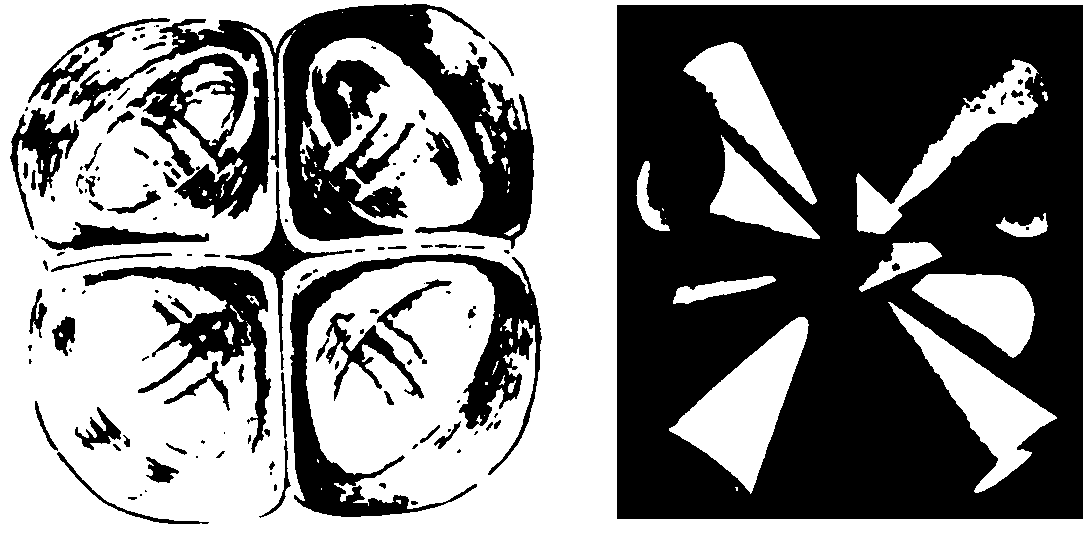
FIG.
130. TYPES OF OCTAHEDRONS

FIG.
130. TYPES OF OCTAHEDRONS
ATOMIC
ANU ELEMENT CENTRE FUNNELS SPIKES
NO.
14
520 Silicon - 8 (BS+4Si15)
32
1,300 Germanium Be4+2Ad24 8 (4Ge39)
50
2,124 Tin Ne120 8 (4Ge39) 6Sn126
65
2.916 Terbium Ne120 8 (4Ge39+2Mo46+U) 6Sn126
82
3,727 Lead T1.687 4 (Ca160+Mo46+4Sn35
+
Pb31)
4
(Ca160 + 4Ge39+ Mo46
+Pb21)
224
OCCULT CHEMISTRY

Silicon is at the head of the group and corresponds to Carbon on the opposite extremity of the swing of the pendulum. It has eight funnels containing a group of five Anu, B5, and four ovoids in a circle, Si15, but no central sphere of any kind. All the funnels are alike and open on the faces of an octahedron. Fig. 131.
Silicon
= 8(B5+4Si15)
8
funnels of 65 Anu == 520 Anu
Central
globe. In this case the funnels radiate from a central globe formed
of two intersecting tetrahedrons, 2Ad24. These tetrahedrons enclose a tiny
globe of four Anu. Fig. 131.
Funnels.
There
are eight similar funnels each consisting of four segments. The segments
are similar and contain three ovoids Gell and an Ad6. Thus the segments
each contain 39 Anu. This group, Ge39, occurs frequently.
Germanium
= (Be4+2Ad24)+8(4Ge39)
Central
globe = 52 Anu
8
funnels each 156 Anu = 1?.A8
Total
= 1300 Anu
Number
weight
~ = 7222
226
OCCULT CHEMISTRY
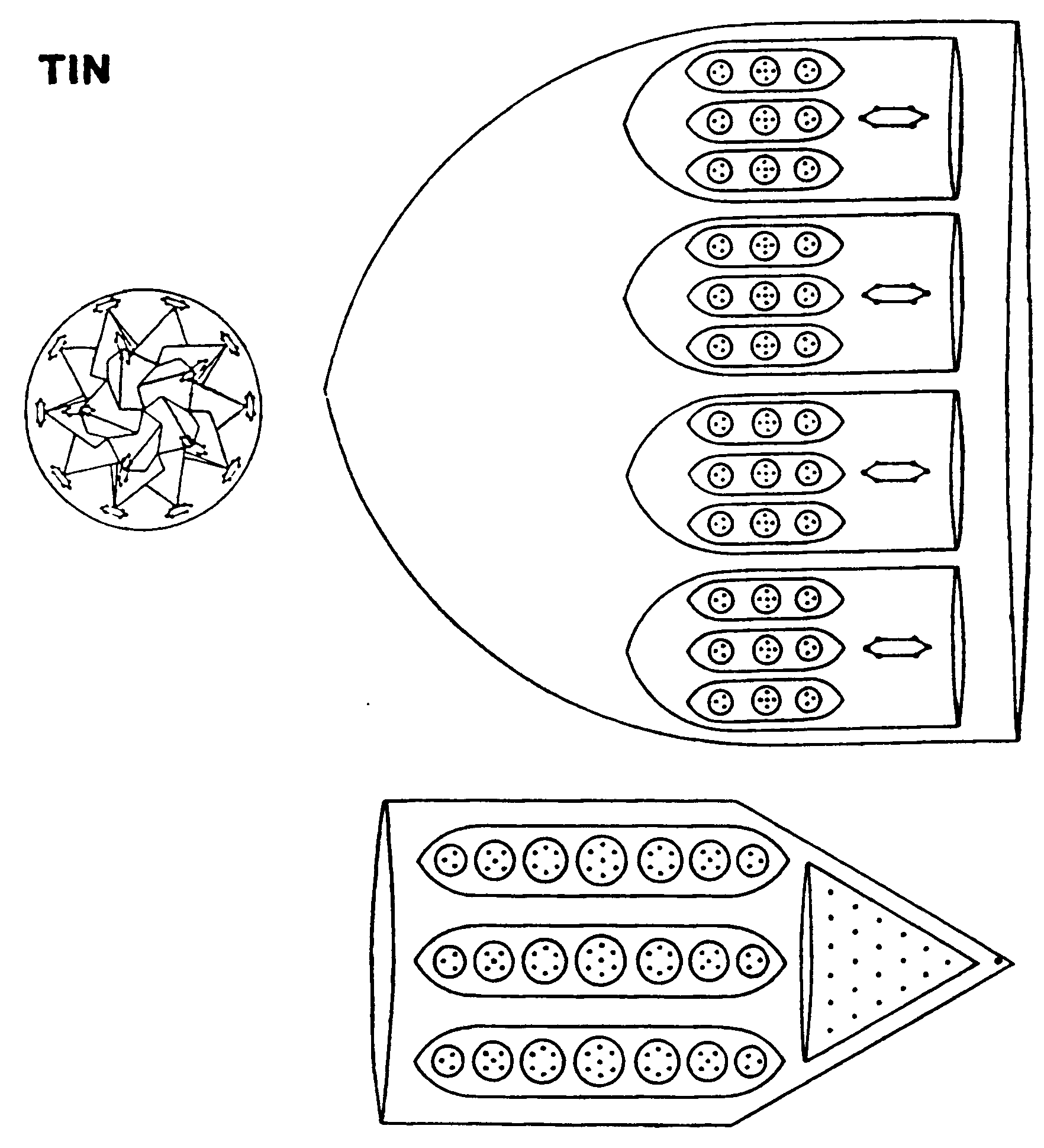
FIG.
132 TIN
Central globe. The central globe consists of the five interpenetrating tetrahedrons. Ne120. Tin omits the eight Anu at the centre found in Titanium. Fig. 132.
Funnels. The funnels of Tin are similar to those of Germanium and contain four segments of Ge39, making a total of 156 Anu.
Spikes. To make room for the necessary increase in the number of Anu, Tin adopts the system of spikes met with in Zinc and other elements. These spikes radiate from the central globe but are only six in number. They point to the corners of the octahedron. In each spike there are three pillars and a cone. The pillars, Sn35, are new in detail though not in principle. They consist of small globes containing 3, 5, 6, 7, 6, 5, 3. Anu respectively. The cone at the top of the spike has 21 Amu and is identical with the cone in Silver, Ag21. The total number of Anu in the spike is 126.
Tin
= Ne120-f-8 (4Ge39) + 6Sn126
Central
globe = 120 Anu
8
funnels each 156 Anu = 1248 _
6
spikes each 126 Anu = 756 ,.
Total
= 2124 Anu
228
OCCULT CHEMISTRY
ATOMIC No. 6s. TERBIUM
This element resembles Tin and Lead. It was found in solder. Central globe. This is similar to that of Tin, being composed of Ne120. Fig: 133. Funnels. The eight similar funnels each contain four Ge39, two Mo46 and one L7, making a total of 255 Anu. Fig. 134. Spikes. There are six spikes similar to those of Tin, each composed of Sn126. Fig. 134.
Terbium
--- Ne120+8 (4Ge39+2Mo46+L7)+6Sn126
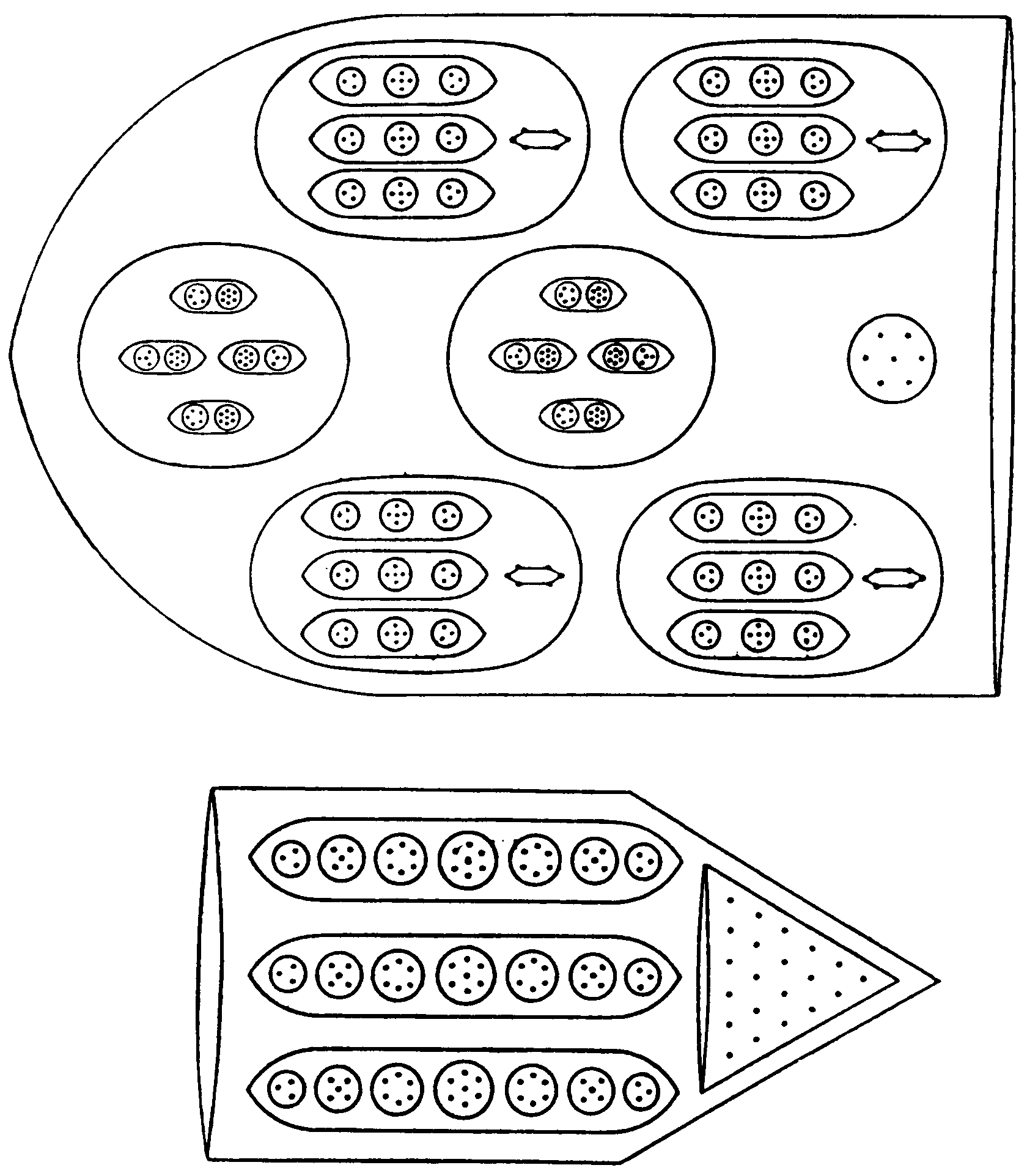
FIG.
134. TERBIUM, FUNNEL AND SPIKE
230 OCCULT CHEMISTRY
ATOMIC
NO. 82 LEAD
Central globe. The central globe in Lead is similar to that of Thallium and Bismuth. It is made up of the group Ce27 at the centre, surrounded by 20 segments each of Ba33, making the total T1.687. Fig. 135.
Funnels. Lead has no spikes but has eight funnels of two types. Some of the constituents of the spikes have been used in the funnels. Fig. 136.
Type A contains Ca160, one Mo46, four pillars from the Tin spike, Sn35, and finally, at the mouth of the funnel, there is a sphere P631. The total makes up 377 Anu.
Type B contains Ca160 and Mo46. It adds 4 Ge39 groups and an ovoid Pb21 at the mouth of the funnel The total makes up 383 Anu.
Lead
= T1687+4(Ca160+Mo46+4Sn35-1-P631)
+4(Ca160+Mo46+4Ge39+Pb21)
 THE
OCTAHEDRON GROUP B 231
THE
OCTAHEDRON GROUP B 231

FIG.
136. LEAD FUNNELS
332
OCCULT CHEMI3TRY
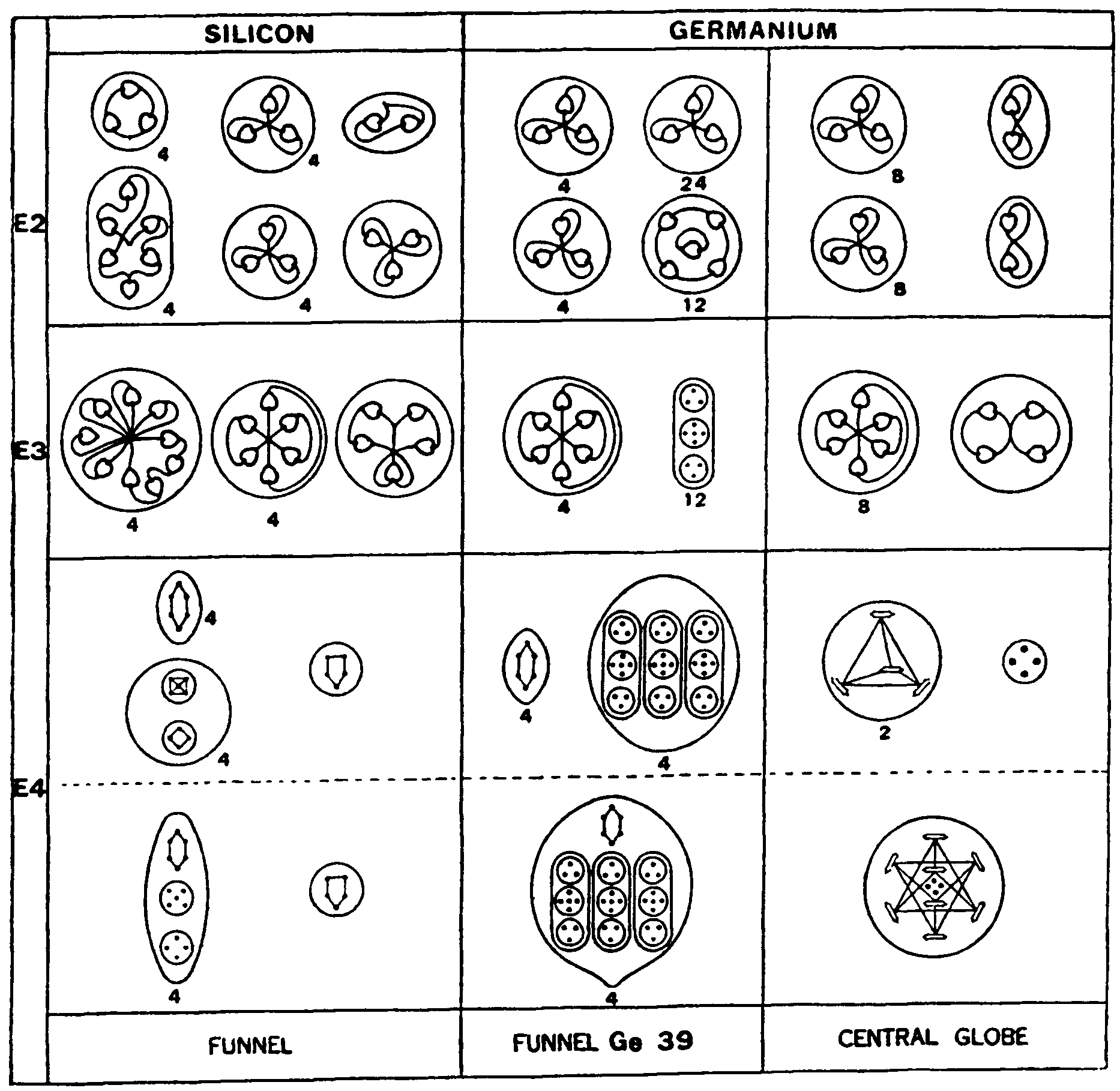
FIG.
137. DISINTEGRATION OF SILICON AND GERMANIUM
On the E4 level the four ovoids Si15 and the B5 are first liberated from the funnels. The four Ad6 then escape from their ovoids, leaving the quintet and quartet together in a sphere, as shown in Fig. 137.
On the E3 level the quintet and quartet join together to form a group of nine Anu. The Ad6 gives its usual sextet and the B5 a quintet.
On
the E2 level the group of nine Anu divides into a sextet and a triplet,
the Ad6 sextet gives two triplets and the quintet a triplet and a duad.
Funnels. The four large ovoids, Ge39, in the funnels are first set free on the E4 level Then the cigar Ad6 bursts its way through and goes along its accustomed path. The three groups, Gell, are left in the ovoids.
234
OCCULT CHEMISTRY

FIG.
138. DISINTEGRATION OF TIN
Funnels. The funnels are exactly like those of Germanium and disintegrate as shown under Germanium. Fig. 137.
Central globe. The central globe, Ne120, is first liberated on the E4 level. It then breaks up into its five tetrahedrons, 5Ad24. On the E3 level these tetrahedrons each give four sestets, and these sextets each give two triplets on the E2 level. Fig. 138.
Spikes. The three pillars, Sn35, are liberated on the E4 level and become spheres, the single septet being at the centre and the other six bodies circling round it on differing planes. On the E3 level these seven spheres are liberated and form groups as shown in Fig. 138. They disintegrate further on the E2 level giving a quartet, triplets, duads and units.
The
cone in the spike, Ag21, is also set free on the E4 level. This is really
a pyramid as in Silver. On the E3 level three septets are formed and on
the E2 level six triplets and three units.
236
OCCULT CHEMISTRY
Fig. 139 shows the Octahedron Group B in a condensed form, from which the relationships in the group may be studied.
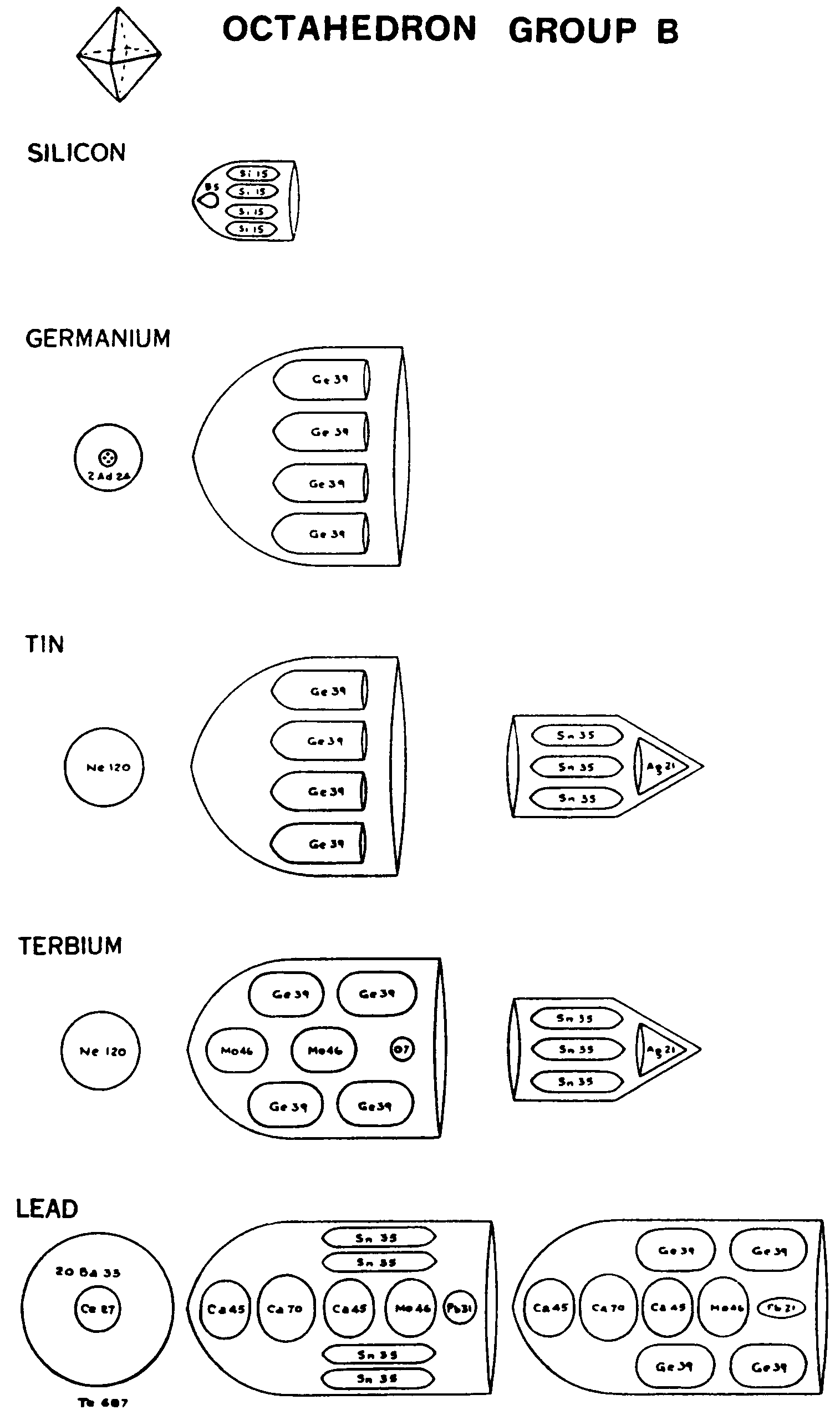
FIG.
139 THE OCTAHEDRON GROUP B